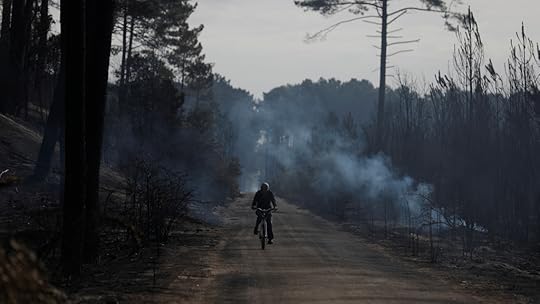Steve Bull's Blog, page 1277
October 23, 2017
US Targets Russian Nord Stream-2 Gas Project: Déjà Vu Story

US Targets Russian Nord Stream-2 Gas Project: Déjà Vu Story
The US Countering Iran’s Destabilizing Activities Act of 2017 contains a separate section called the Countering Russian Influence in Europe and Eurasia Act (“CRIEEA”). CRIEEA authorizes – and at times requires – the President to impose significant new sanctions on the Russian energy, financial, and defense sectors, imperiling the completion of the Russian Nord Stream 2 gas pipeline. It also hits European businesses involved in the project. The legislation can impact a potentially large number of European companies doing legitimate business under EU measures with Russian entities in the railways, financial, shipping or mining sectors, among others. Now the US punitive measures could include the pipelines crossing the territory of Ukraine, as well as pipeline projects in the Caspian region and the development of the Zohr gas field off the coast of Egypt. The law negatively affected the US relationship with European allies.
Russian President Vladimir Putin believes that the world is witnessing an increasing number of examples of politics crudely interfering with economic, market relations. In his address to the final plenary session of the 14th annual meeting of the Valdai Discussion Club on October 19, Putin said “Some do not even conceal that they are using political pretexts to promote their strictly commercial interests. For instance, the recent package of sanctions adopted by the US Congress is openly aimed at ousting Russia from European energy markets and compelling Europe to buy more expensive US-produced LNG although the scale of its production is still too small.”
The US is striving to control the EU decision-making process. According to Washington’s logic, building a pipeline to reduce costs and raise reliability and efficiency proves that Russia is politically motivated, unlike the US with its new law adopted to pave the way for American LNG exports to Europe using coercive measures!
…click on the above link to read the rest of the article…
Madagascar Hospitals On High Alert: ‘No One Is Safe’ From The Black Plague

Travelers are being warned to keep their distance from areas of Madagascar affected by the bubonic plague. As the outbreak worsens, some doctors are even warning that “no one is safe” from the disease.
The outbreak of the black plague in Madagascar has so far killed 97 people, and doctors are warning that it will be continuing to spread and worsen, meaning no one is safe. Health officials say the disease, which contributed to the deaths of more than 50 million people in Europe during the Middle Ages, has spread from rural areas to the more urban areas not usually affected. Hundreds of cases are reported on the tropical island every year, but experts are warning the epidemic is “much more dangerous” than in previous years.
Officials have reported infections in 17 of the island nation’s 22 regions since the outbreak started in August. And the number of cases is growing by the day, said Elhadj As Sy, the secretary general of the International Federation of Red Cross and Red Crescent Societies (IFRC) as the nation put all hospitals on high alert. The hospitals have also begun implementing preventative measures with attempts to stall the spread of the bacterial infection.
The IFRC said it’s introducing the same “safe and dignified” burial methods used in West Africa during the 2014 Ebola epidemic. This helps cut the chain of transmission by preventing further infections through direct contact with infected corpses.
Last week, less than 60 people had died and around 600 had been infected. Now, there are 911 confirmed cases in addition to the almost 100 deaths. While cases of bubonic plague occur in Madagascar nearly every year, the much more dangerous and deadly pneumonic plague has never been so prevalent.
…click on the above link to read the rest of the article…
Europe’s hurricane-fueled wildfires might become a recurring nightmare

REUTERS/Rafael Marchante
WE DID START THE FIRE
Europe’s hurricane-fueled wildfires might become a recurring nightmare
This week, a hurricane broadsided Europe — a rare event considering most of the continent is closer to the North Pole than it is to the tropics. That would have been enough to make worldwide news, but the continent was due for much more.
As the storm, named Ophelia, approached, it was the strongest hurricane ever recorded in the eastern Atlantic. Although weather watchers were initially focused most closely on Ireland, where the storm made landfall, its deadliest impact occurred hundreds of miles south in Portugal and Spain.
There, strong winds stoked hundreds of wildfires, killing more than 40 people. The ghastly images from southwestern Europe looked less like real life than illustrations from a cautionary fairy tale about the end of the world. Being there, as one person wrote, was like “a nightmare world of smoke and ash.”
These fires would have been the deadliest in Portugal’s history, were it not for massive blazes in June that killed more than 60 people, trapping many in their cars, as flames advanced too quickly for them to escape.
With its vast forests and typically warm and dry summers, Portugal is already Europe’s wildfire capital. And in recent decades, its profound and unique socioeconomic vulnerability to fire has only grown. Last year, half of the fire acreage burned in all of Europe lay in Portugal — a trend attributed both to haphazard forestry practices and climate change bringing hotter and drier weather.
This year, the sheer scale of the fires has been staggering. On Sunday alone, wildfires burned at least 300,000 acres — more than is normally burned in an entire year. Smoke from the fires quickly spread as far away as London.
…click on the above link to read the rest of the article…
Norway Unfazed By Peak Oil Concerns

When crude oil demand will peak is anyone’s guess. Forecasts vary widely. Wood Mackenzie says that peak demand is “very real,” and sees a decline of 4 million bpd between 2020 and 2035. Other majors including BP and Total SA see peak demand as coming between 2025 and 2040, as a result of clean energy government initiatives, slower economic growth, and wider use of electric vehicles.
Not everyone is that concerned with peak oil demand, however. Recently, Norway’s Energy Minister said the biggest problem for Europe’s largest oil and gas producer is satisfying near-term demand, which is growing faster than Norwegian continental shelf operators are making discoveries.
It might sound a bit weird that Europe’s greenest country is still so big on oil and gas, but in reality, there’s nothing weird: Oil and gas exports account for a substantial portion of Norway’s export revenues, with their value for 2016 standing at $43.84 billion (350 billion crowns), accounting for 47 percent of the country’s total export value.
Norway’s biggest customer is the European Union. Together with Saudi Aramco, Norway’s state major Statoil accounted for a fifth of the EU oil market last year. Yet demand in the EU is supposed to be falling, with rigorous policies designed to encourage acceleration of the shift to renewable energy.
Indeed, according to European Union statistics, demand is on a stable downward curve thanks to greater energy use efficiency, “structural changes in the economy”, and lower demand for fuels. Still, Eurostat notes, crude oil and its derivatives account for the biggest share of energy consumption in the 28-strong union.
That’s good news for Norway, and there’s more good news from Wood Mackenzie. The energy consultancy has forecast that although in places like Europe, Japan, the United States, and even China, crude oil consumption will plateau by 2035, the demand for petrochemicals will jump considerably.
…click on the above link to read the rest of the article…
The Strange World of Russian ‘Trolls’
A big part of the Russia-gate hysteria is to accuse Russia of spreading U.S. dissension via Internet “trolling,” but that’s just one more wild exaggeration among many, as William Blum describes at Anti-Empire Report.
Webster’s dictionary: troll – verb: To fish by running a baited line behind a moving boat; noun: A supernatural creature of Scandinavian folklore.

Red Square in Moscow with a winter festival to the left and the Kremlin to the right in December 2016. (Photo by Robert Parry)
Russian Internet trolls are trying to stir up even more controversy over National Football League players crouching on one knee (“taking a “knee”) during the national anthem, said Sen. James Lankford (R-Okla.), warning that the United States should expect such divisive efforts to escalate in the next election.
“We watched even this weekend,” Lankford said, “the Russians and their troll farms, and their Internet folks, start hash-tagging out ‘take a knee’ and also hash-tagging out ‘Boycott NFL’.” The Russians’ goal, he said, was “to try to raise the noise level in America to try to make a big issue, an even bigger issue as they’re trying to just push divisiveness in the country. We’ve continued to be able to see that. We will see that again in our election time.”
Russia “causing divisiveness” is a common theme of American politicians and media. Never explained is WHY? What does Russia have to gain by Americans being divided? Do they think the Russians are so juvenile? Or are the Americans the childish ones?
CNN on Oct. 12 claimed that Russia uses YouTube, Tumblr and the Pokemon Go mobile game “to exploit racial tensions and sow discord among Americans,” while the Washington Post (Oct. 12) reported that “content generated by Russian operatives was not aimed only at influencing the election. Many of the posts and ads intended to divide Americans over hot-button issues such as immigration or race.”
…click on the above link to read the rest of the article…
Germany: Full Censorship Now Official
Courts Rewrite History
Germany has made no secret of its desire to see its new law copied by the rest of the EU.
When employees of social media companies are appointed as the state’s private thought police and given the power to shape the form of current political and cultural discourse by deciding who shall be allowed to speak and what to say, and who shall be shut down, free speech becomes nothing more than a fairy tale. Or is that perhaps the point?
Perhaps fighting “Islamophobia” is now a higher priority than fighting terrorism?
A new German law introducing state censorship on social media platforms came into effect on October 1, 2017. The new law requires social media platforms, such as Facebook, Twitter, and YouTube, to censor their users on behalf of the German state. Social media companies are obliged to delete or block any online “criminal offenses” such as libel, slander, defamation or incitement, within 24 hours of receipt of a user complaint — regardless of whether or the content is accurate or not. Social media companies receive seven days for more complicated cases. If they fail to do so, the German government can fine them up to 50 million euros for failing to comply with the law.
This state censorship makes free speech subject to the arbitrary decisions of corporate entities that are likely to censor more than absolutely necessary, rather than risk a crushing fine. When employees of social media companies are appointed as the state’s private thought police and given the power to shape the form of current political and cultural discourse by deciding who shall be allowed to speak and what to say, and who shall be shut down, free speech becomes nothing more than a fairy tale. Or is that perhaps the point?
…click on the above link to read the rest of the article…
October 22, 2017
Censorship in the Digital Age
The grand experiment with western democracy, badly listing thanks to broadsides from profiteering oligarchs, may finally run ashore on the rocks of thought crime. In the uneven Steven Spielberg project Minority Report, starring excitable scientologist Tom Cruise, Cruise plays a futuristic policeman who investigates pre-crimes and stops them before they happen. The police owe their ability to see the criminal plots developing to characters called pre-cognitives, or pre-cogs, kind of autistic prophets who see the future and lie sleeping in sterile pools of water inside the police department. Of course, it turns out that precogs can pre-visualize different futures, a hastily hidden flaw that threatens to jeopardize the profits of the pre-crime project. Here is the crux of the story: thought control is driven by a profit motive at bottom. As it turns out, just like real life.
Now, the British government has decided to prosecute pre-crime but has done away with the clunky plot device of the pre-cogs, opting rather to rely on a hazy sense of higher probability to justify surveilling, nabbing, convicting, and imprisoning British citizens. The crime? Looking at radical content on the Internet. What is considered radical will naturally be defined by the state police who will doubtless be personally incentivized by pre-crime quotas, and institutionally shaped to criminalize trains of thought that threaten to destabilize a criminal status quo. You know, the unregulated monopoly capitalist regime that cuts wages, costs, and all other forms of overhead with psychopathic glee. Even a Grenfell Towers disaster is regarded more as a question of how to remove the story from public consciousness than rectify its wrongs.
…click on the above link to read the rest of the article…
For The First Time In 26 Years, US To Put Nuclear Bombers On 24 Hour Alert
The unexpected decision by President Trump to amend an emergency Sept 11 order signed by George W Bush, allowing the Air Force to recall up to 1,000 retired air force pilots to address what the Pentagon has decribed as “an acute shortage of pilots” caught us by surprise. After all, this was the first time we have heard of this particular labor shortage – perhaps there was more to this executive order than meets the eye. Indeed, a just released report may help explain the reasoning behind this presidential decision.
According to Defense One, the US Air Force is preparing to put nuclear-armed bombers back on 24-hour ready alert, a status not seen since the Cold War ended in 1991.
That means the long-dormant concrete pads at the ends of Barksdale Air Force Base’s 11,000-foot runway — dubbed the “Christmas tree” for their angular markings — could once again find several B-52s parked on them, laden with nuclear weapons and set to take off at a moment’s notice.
“This is yet one more step in ensuring that we’re prepared,” Gen. David Goldfein, Air Force chief of staff, told the publication in an interview during his six-day tour of Barksdale and other U.S. Air Force bases that support the nuclear mission. “I look at it more as not planning for any specific event, but more for the reality of the global situation we find ourselves in and how we ensure we’re prepared going forward.”
Quoted by Defense One, Goldfein and other senior defense officials stressed that the alert order had not been given, but that preparations were under way in anticipation that it might come. That decision would be made by Gen. John Hyten, the commander of U.S. Strategic Command, or Gen. Lori Robinson, the head of U.S. Northern Command. STRATCOM is in charge of the military’s nuclear forces and NORTHCOM is in charge of defending North America.
…click on the above link to read the rest of the article…
Low Interest Rates Subsidize Wealthy Households

When the economy begins to sink into recession, politicians, mainstream economists, policy wonks, and the Federal Reserve begin beating the economic stimulus drum.
Politicians, however, disagree over the type of stimulus to implement. The center-left party proposes greater expenditures on public assistance programs. The center-right party supports permanent tax rate reductions. The center-left party opposes tax cuts because they say it benefits the rich. The center-right party opposes raising government expenditures because it increases government debt. This discord generally results in a temporary compromise where government expenditures are boosted and tax rates are cut. This compromise is called “discretionary fiscal stimulus.”
While the debate over discretionary fiscal stimulus has to overcome Senate filibusters and heated House debates, the central bankers at the Fed quickly implement monetary stimulus. Boosting aggregate demand is the intended purpose of it and discretionary fiscal stimulus. In mainstream economic theory, greater aggregate demand lowers unemployment and raises GDP. In spite of grave warnings from Austrian-school economists, the Fed pursues these goals by lowering interest rates via an expansion credit.
Although the political parties disagree over the type of fiscal stimulus to implement, both support the Fed’s monetary stimulus. Perhaps they do so because lower interest rates lower the cost of the budget deficits their discretionary fiscal stimulus produces. The lower interest rates also reduce the interest Americans pay on their debts. The total of this debt is unevenly distributed across the richest 1 percent, the next 9 percent, and the bottom 90 percent of Americans (as ranked by wealth), according to the following table.

Total household debt averaged $11.295 trillion dollars over the four quarters in 2013, according to the Federal Reserve Bank of New York. Multiplying this value by the percentages in the above table indicates that the richest 1 percent, the next 9 percent, and the bottom 90 percent have aggregate debts of $610 billion, $2.383 trillion, and $8.302 trillion, respectively. These values are listed in the Total Debt column below.
…click on the above link to read the rest of the article…
Here Is The IMF’s Global Financial Crash Scenario
Hidden almost all the way in the end of the first chapter of the IMF’s latest Financial Stability Report, is a surprisingly candid discussion on the topic of whether “Rising Medium-Term Vulnerabilities Could Derail the Global Recovery”, which is a politically correct way of saying is the financial system on the verge of crashing.
In the section also called “Global Financial Dislocation Scenario” because “crash” sounds just a little too pedestrian, the IMF uses a DSGE model to project the current global financial sitution, and ominously admits that “concerns about a continuing buildup in debt loads and overstretched asset valuations could have global economic repercussions” and – in modeling out the next crash, pardon “dislocation” – the IMF conducts a “scenario analysis” to illustrate how a repricing of risks could “lead to a rise in credit spreads and a fall in capital market and housing prices, derailing the economic recovery and undermining financial stability.”
* * *
From the IMF’s Financial Statbility Report:
“Could Rising Medium-Term Vulnerabilities Derail the Global Recovery?”
This section illustrates how shocks to individual credit and financial markets well within historical norms can propagate and lead to larger global impacts because of knock-on effects, a dearth of policy buffers, and extreme starting points in debt levels and asset valuations. A sudden uncoiling of compressed risk premiums, declines in asset prices, and rises in volatility would lead to a global financial downturn. With monetary policy in several advanced economies at or close to the effective lower bound, the economic consequences would be magnified by the limited scope for monetary stimulus. Indeed, monetary policy normalization would be stalled in its tracks and reversed in some cases.
…click on the above link to read the rest of the article…



